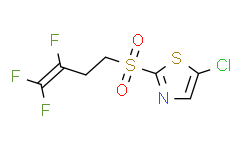| Cas No.: | 318290-98-1 |
| Chemical Name: | FLUENSULFONE |
| Synonyms: | FLUENSULFONE;5-Chloro-;5-Chloro-2-[(3,4,4-trifluoro-3-buten-1-yl)sulfonyl]thiazole;5-Chloro-2-[(3,4,4-trifluorobut-3-en-1-yl)sulfonyl]-1,3-thiazole;5-chloro-1,3-thiazol-2-yl 3,4,4-trifluorobut-3-en-1-yl sulfone;5-chloro-2-(3,4,4-trifluorobut-3-en-1-ylsulfonyl)-1,3-thiazole;5-chloro-2-(3,4,4-trifluorobut-3-ene-1-sulfonyl)-1,3-thiazole;5-chloro-2-(3,4,4-trifluorobut-3-enylsulfonyl)-1,3-thiazole;MCW 2 |
| SMILES: | F/C(F)=C(F)\CCS(=O)(C1=NC=C(Cl)S1)=O |
| Formula: | C7H5NO2F3S2Cl |
| M.Wt: | 291.6983 |
| Sotrage: | 2 years -20°C Powder, 2 weeks 4°C in DMSO, 6 months -80°C in DMSO |
| Description: | Fluensulfone is a new nematicide for chemical control of plant parasitic nematodes. |
| In Vivo: | In an in vivo investigation, female mice are treated with Fluensulfone (or isoniazid as a positive control) for 3 and 7 days. Quantification of the cell proliferation by manual counting of BrdU-positive and BrdU-negative cells in the bronchiolar epithelium reveals an approximately fourfold increase of cell proliferation upon treatment with Fluensulfone and the positive control isoniazid compare with control. Increased cell proliferation is observed at 3 days but have reverted to the control level at day 7 [2]. |
| In Vitro: | Lower concentrations of Fluensulfone delay development: 100 μM Fluensulfone causes a slight delay as at 66 h fewer worms have reached the adult stage whilst at 300 μM no worms reach the adult stage at 66 h and some fail to reach L4. Adult hermaphrodites lay fewer eggs in the presence of 1 mM Fluensulfone. Fluensulfone is also found to reduce the viability of eggs. After 3 h incubation with 100 μM to 1 mM Fluensulfone the thrashing rate is significantly inhibited, with maximal inhibition occurring with 1 mM. After 1 h both 300 μM and 1 mM Fluensulfone cause a significant and reversible inhibition of pharyngeal pumping relative to the vehicle control. Fluensulfone (500 μM) inhibits the frequency of body bends in one day old adult hermaphrodites off food after 2 h exposure[1]. |

 To enhance service speed and avoid tariff delays, we've opened a US warehouse. All US orders ship directly from our US facility.
To enhance service speed and avoid tariff delays, we've opened a US warehouse. All US orders ship directly from our US facility.





















